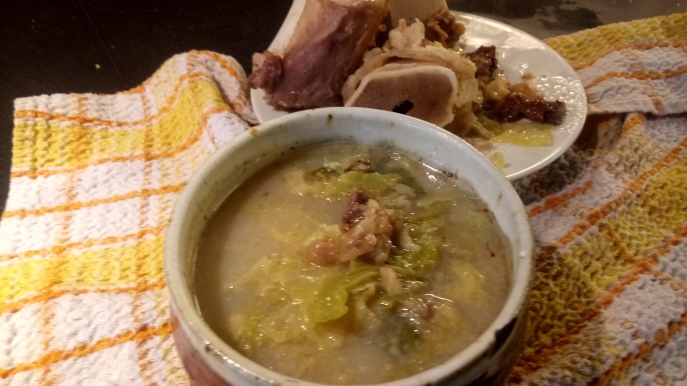The two part cooking of chicken is for two reasons:
- Chickens humours are of a dry humour and you need to simmer them to add moist to balance them, and
- it insures that the chicken is cooked through so it won’t make someone who is cooking without reliable heat, or meat thermometer, ill.
I used chicken legs but this recipe calls for Capon, which is much more expensive.
The apples are cut into quarters, this could mean that you should have chunks of apples when the sauce is done cooking, or that the cook knows they will cook long enough to thicken sauce. Or both!
I think the flavour from the pine nuts helps balance out the sweetness of the other sauce ingredients. If you needed to remove the pine nuts I’d try dried mushrooms or toasted almonds to give a umami, or savoury taste.
Hungarian Capon in pottage. Take a slightly cooked capon, cut it into quarters, & fry in butter a little, that it is not at all black: then take onions cut into slices, & apples cut into little quarters, & fry in butter, & cast it on the capon in a pot: then put therein a little broth & wine, & let it boil again, & put herein saffron, sugar, cinnamon, nutmeg, pine nuts, & make stew well until it is well cooked, & serve. Ouverture de Cuisine
(France, 1604 – Daniel Myers, trans.)
Ingredients
- 6 chicken pieces
- 1 tbsp & 1 tbsp salted butter
- 1 onion, sliced
- 2 apples, peeled, quartered, cores removed
- 1.5 cups broth
- 1/2 cup wine
- 1 pinch saffron
- 1 tbsp sugar
- 1 tsp cinnamon
- 1/2 tsp nutmeg
- 1/2 cup pine nuts**
DIrections
- Heat a deep cast iron frying pan on medium. Add chicken pieces and 1 tbsp butter, fry until chicken is brown. Remove chicken from pan and set aside.
- Add 1 tbsp butter to chicken pan* with onions and apple pieces. Fry until onions soften.
- Gently place chicken back to pan, cover with broth and wine and then bring to a boil.
- Stir in remaining ingredients and reduce heat. Cover and simmer for 20-30 minutes, until chicken falls off bone or is well cooked. Your kitchen will smell wonderful.
- Serve chicken with cooking liquid.
*It is a different instruction from the original but I like using one pan when I can instead of two. If pressed for time fry apples and onions in a second pot as you are browning chicken pieces.
**Costs more than the chicken did.







